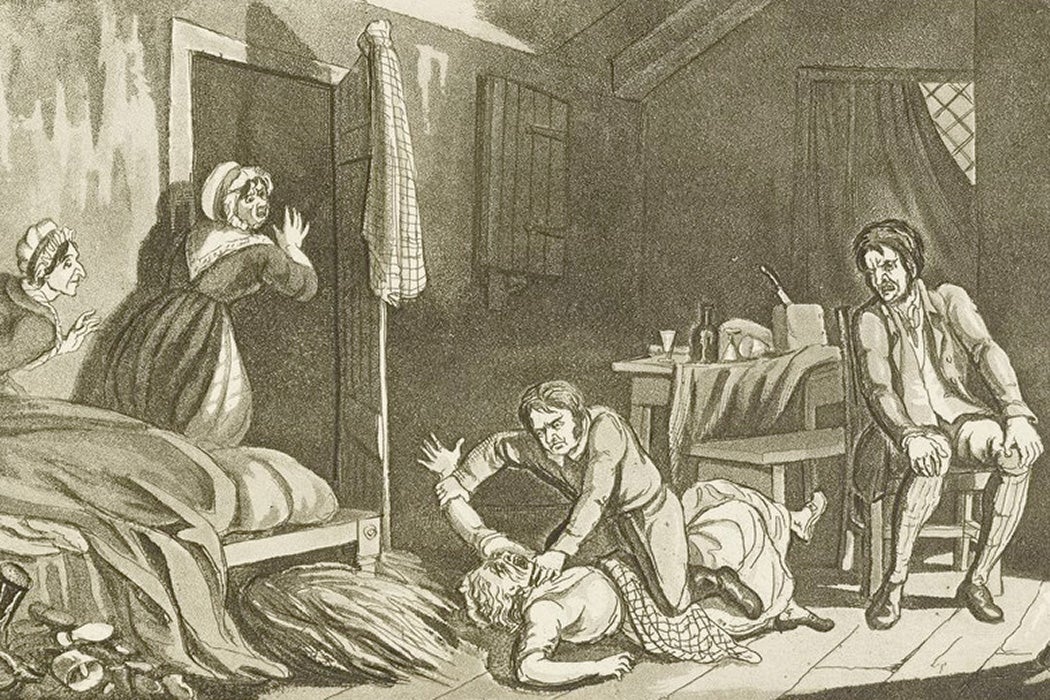In 1828, William Burke and William Hare murdered at least sixteen people in Edinburgh, Scotland. They were “resurrection men” who skipped the resurrection part. Instead of disinterring recent burials, they killed to meet the feverish demand for corpses from the city’s figuratively and literally cut-throat anatomy schools.
Burke was convicted on the basis of Hare’s testimony. For giving up his partner, Hare was let free, and he escaped with his hide intact. Burke’s fate, meanwhile, was to be legally “scragged, ottomised, and grin in a glass case.” That is, he was executed by hanging, publicly dissected—causing a near riot amongst those who wanted to watch—and his skeleton put on display in the Anatomical Museum (where it remains to this day). Also, gruesomely, Burke’s skin was tanned and sold for souvenirs. William Roughead begins his classic retelling of the “West Port Murders” by describing the piece of Burke’s skin he inherited from his grandfather.
Robert Louis Stevenson immortalized the resurrectionists in “The Body Snatcher” (1884), and “burke” became a verb meaning to smother someone or suppress something. But what every happened to the anatomist—Stevenson’s “Mr. K”—to whom they sold their victims? Everybody knew who he was: “Burke’s the butcher, Hare’s the thief / Knox the boy that buys the beef” went the local rhyme.

Edinburgh was then a world center of anatomical study. To meet the demand, a number of anatomists lectured outside the university. The most popular of these was one-eyed Robert Knox, renowned for both his lectures and his scathing criticism of his competitors and society at large. Hundreds attended his lectures. It was his school that purchased the victims of Burke and Hare, some still warm, for £8–10 each. (This was big money for the shilling-scant). Knox’s students actually recognized some of Burke and Hare’s victims, including prostitute Mary Paterson and the amiable street wanderer “Daft Jamie” Wilson. Yet no questions were asked about the bodies.
As Knox didn’t personally deal with Burke and Hare, he wasn’t prosecuted. A Royal Society commission exonerated him. This outraged many: he was burnt in effigy and his home was ransacked. Knox slipped away for a while but returned. He was in bad odor, but his students loved him, at least until the 1832 Anatomy Act made bodies available to all who needed them. Knox left Edinburgh in 1842 in great bitterness and didn’t teach anatomy after 1844. He supported himself through writing and lecturing and died in 1862 at the age of seventy-one.
Historian Evelleen Richards closely examines Knox’s legacy. It’s overshadowed by his connection to the rapid-resurrectionists, of course, but he also a a key figure in the history of transcendental anatomy and pseudoscientific racism.
Transcendental anatomy was the idea that all organisms had common structures and that ideal patterns could be discovered therein. Knox, in his own words, believed anatomy was a philosophical and moral issue, a way of “detecting the laws of organic life, the origin of living beings, and the transcendental laws regulating the living world in time and space.”
A radical in part, Knox opposed “Kingcraft,” “Priestcraft,” British colonialism, and slavery, but he didn’t subscribe to Enlightenment egalitarianism. He believed in the “essential inequality of humanity.” Another scholar, quoted by Richards, has called Knox the “real founder of British racism.”
Knox’s racial ideas were mostly set down in The Races of Men (1850). For Knox, race was a biological fact. Physical differences aligned with mental differences. The human races were so different and distinct they were “entitled to the name of species.” The American edition of The Races of Men inspired “some of the more notorious and influential American proslavery texts and were reimported into England.”
Knox applied an “extremely blunt scalpel to the task of social dissection” in his “disorganized, vehement and scattered writings,” writes Richards. Others took up that blunt scalpel and carved up humanity with it—literally, in the case the “social surgeons” of the eugenics movement who sterilized the poor.
As Richards shows, the “appropriation, retooling, and institutionalization of Knox’s ‘moral anatomy’” inspired “self-proclaimed disciples” of Knox to found British anthropology as reactionary, anti-Darwinian, polygenic (human races as separate species), and imperially racist. As Richards writes, loyal followers kept resurrecting Knox from the dead to use for their political/biological agendas.
Support JSTOR Daily! Join our membership program on Patreon today.







